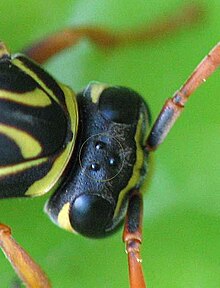
A simple eye or ocellus (sometimes called a pigment pit) is a form of eye or an optical arrangement which has a single lens without the sort of elaborate retina that occurs in most vertebrates. These eyes are called "simple" to distinguish them from "compound eyes", which have multiple lenses. They are not necessarily simple in the sense of being uncomplicated or basic.
The structure of an animal's eye is determined by the environment in which it lives, and the behavioural tasks it must fulfill to survive. Arthropods differ widely in the habitats in which they live, as well as their visual requirements for finding food or conspecifics, and avoiding predators. Consequently, an enormous variety of eye types are found in arthropods to overcome visual problems or limitations.
Use of the term simple eye is flexible, and must be interpreted in proper context; for example, the eyes of most large animals are camera eyes and are sometimes considered "simple" because a single lens collects and focuses an entire image onto the retina (analogous to a camera). By other criteria, the presence of a complex retina distinguishes the vertebrate camera eye from the simple stemma or ommatidia which make up compound eyes. Additionally, not all invertebrate ocelli and ommatidium have simple photoreceptors. Many have various forms of retinula (a retina-like cluster of photoreceptor cells), including the ommatidia of most insects and the central eyes of camel spiders. Jumping spiders and some other predatory spiders with seemingly simple eyes also emulate retinal vision in various ways. Many insects have unambiguously compound eyes consisting of multiple lenses (up to tens of thousands), but achieve an effect similar to that of a camera eye, in that each ommatidium lens focuses light onto a number of neighbouring retinulae.
Ocelli or eye spots
Some jellyfish, sea stars, flatworms, and ribbonworms have the simplest "eyes" – pigment spot ocelli – which have randomly distributed pigment, and which have no other structure (such as a cornea, or lens). The apparent "eye color" in these animals is red or black. Certain groups such as box jellyfish have more complex eyes, including some with a distinct retina, lens, and cornea.
Many snails and slugs also have ocelli, either at the tips or bases of their tentacles. Some other gastropods, such as the Strombidae, have much more sophisticated eyes. Giant clams have ocelli that allow light to penetrate their mantles.
Simple eyes in arthropods
Spider eyes
Main article: Spider vision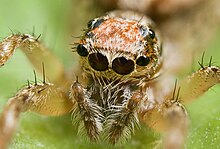

Spiders do not have compound eyes, but instead have several pairs of simple eyes with each pair adapted for a specific task or tasks. The principal and secondary eyes in spiders are arranged in four, or occasionally fewer, pairs. Only the principal eyes have moveable retinas. The secondary eyes have a reflector at the back of the eyes. The light-sensitive part of the receptor cells is next to this, so they get direct and reflected light. In hunting or jumping spiders, for example, a forward-facing pair possesses the best resolution (and even some telescopic ability) to help spot prey from a distance. Nocturnal spiders' eyes are very sensitive in low light levels and are large to capture more light, equivalent to f/0.58 in the rufous net-casting spider.
Dorsal ocelli
The term "ocellus" (plural ocelli) is derived from the Latin oculus (eye), and literally means "little eye". In insects, two distinct ocellus types exist: dorsal (top-most) ocelli, and lateral ocelli (often referred to as ocelli and stemmata, respectively), most insects have dorsal ocelli while stemmata are found in the larvae of some insect orders. Despite the shared name, they are structurally and functionally very different. Simple eyes of other animals may also be referred to as ocelli, but again the structure and anatomy of these eyes is quite distinct from those of insect dorsal ocelli.
Dorsal ocelli are light-sensitive organs found on the dorsal surface or frontal surface of the head of many insects, including Hymenoptera (bees, ants, wasps, sawflies), Diptera (flies), Odonata (dragonflies, damselflies), Orthoptera (grasshoppers, locusts) and Mantodea (mantises). These ocelli coexist with compound eyes; thus, most insects possess two anatomically separate and functionally different visual pathways.
The number, forms, and functions of the dorsal ocelli vary markedly throughout insect orders. They tend to be larger and more strongly expressed in flying insects (particularly bees, wasps, dragonflies and locusts) where they are typically found as a triplet. Two ocelli are directed to either side of the head, while a central (median) ocellus is directed forwards. In some terrestrial insects (e.g. some ants and cockroaches), the median ocellus is absent. The sideways-facing ocelli can be called "lateral ocelli", referring to their direction and position in the triplet, however this is not to be confused with the stemmata of some insect larvae, which are also known as lateral ocelli.
A dorsal ocellus consists of a lens element (cornea) and a layer of photoreceptors (rod cells). The ocellar lens may be strongly curved or flat. The photoreceptor layer may also be separated from the lens by a clear vitreous humour. The number of photoreceptors also varies widely, but may number in the hundreds or thousands for well-developed ocelli. In bees, locusts, and dragonflies, the lens is strongly curved; while in cockroaches it is flat. Locusts possess vitreous humour while blowflies and dragonflies do not.
Two somewhat unusual features of ocelli are particularly notable and generally common between insect orders.
- The refractive power of the lens is not typically sufficient to form an image on the photoreceptor layer, essentially it is out of focus.
- Dorsal ocelli ubiquitously have massive convergence ratios from first-order (photoreceptor) to second-order neurons.
These two factors have led to the conclusion that, with some exceptions in predatory insects, the ocelli are incapable of perceiving proper images and are thus solely suitable for light-metering functions. Given the large aperture and low f-number of the lens, as well as high convergence ratios and synaptic gains (amplification of photoreceptor signals), the ocelli are generally considered to be far more sensitive to light than the compound eyes. Additionally, given the relatively simple neural arrangement of the eye (small number of synapses between detector and effector), as well as the extremely large diameter of some ocellar interneurons (often the largest diameter neurons in the animal's nervous system), the ocelli are typically considered to be "faster" than the compound eyes.
One common theory of ocellar function in flying insects holds that they are used to assist in maintaining flight stability. Given their underfocused nature, wide fields of view, and high light-collecting ability, the ocelli are superbly adapted for measuring changes in the perceived brightness of the external world as an insect rolls or pitches around its body axis during flight. Locusts and dragonflies in tethered flight have been observed to try and "correct" their flight posture based on changes in light. Other theories of ocellar function have ranged from roles as light adaptors or global excitatory organs to polarization sensors and circadian entrainers.
Recent studies have shown the ocelli of some insects (most notably the dragonfly, but also some wasps) are capable of "form vision" similar to camera eyes, as the ocellar lens forms an image within, or close to, the photoreceptor layer. In dragonflies it has been demonstrated that the receptive fields of both the photoreceptors and the second-order neurons can be quite restricted. Further research has demonstrated these eyes not only resolve spatial details of the world, but also perceive motion. Second-order neurons in the dragonfly median ocellus respond more strongly to upwards-moving bars and gratings than to downwards-moving bars and gratings, but this effect is only present when ultraviolet light is used in the stimulus; when ultraviolet light is absent, no directional response is observed. Dragonfly ocelli are especially highly developed and specialised visual organs, which may support the exceptional acrobatic abilities of these animals.
Research on the ocelli is of high interest to designers of small unmanned aerial vehicles. Designers of these craft face many of the same challenges that insects face in maintaining stability in a three-dimensional world. Engineers are increasingly taking inspiration from insects to overcome these challenges.
Stemmata
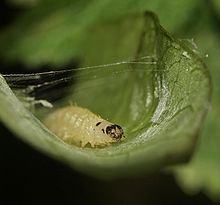
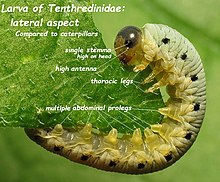
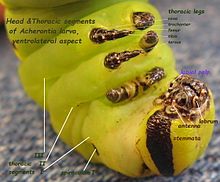
Stemmata (singular stemma) are a class of simple eyes. Many kinds of holometabolous larvae bear no other form of eyes until they enter their final stage of growth. Adults of several orders of hexapods also have stemmata, and never develop compound eyes at all. Examples include fleas, springtails, and Thysanura. Some other Arthropoda, such as some Myriapoda, rarely have any eyes other than stemmata at any stage of their lives (exceptions include the large and well-developed compound eyes of the house centipedes, Scutigera).
Behind each lens of a typical functional stemma lies a single cluster of photoreceptor cells, termed a retinula. The lens is biconvex, and the body of the stemma has a vitreous or crystalline core.
Although stemmata are simple eyes, some kinds (such as those of the larvae of Lepidoptera and especially those of Tenthredinidae, a family of sawflies) are only "simple" in that they represent immature or embryonic forms of the compound eyes of the adult. They can possess a considerable degree of acuity and sensitivity, and can detect polarized light. They may be optimized for light sensitivity, as opposed to detailed image formation. In the pupal stage, such stemmata develop into fully fledged compound eyes. One feature offering a clue to their ontogenetic role is their lateral position on the head; ocelli, that in other ways resemble stemmata, tend to be borne in sites median to the compound eyes, or nearly so. Among some researchers, this distinction has led to the use of the term "lateral ocelli" for stemmata.
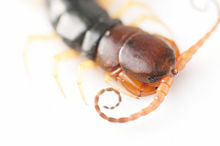
Genetic controls
A number of genetic pathways are responsible for the occurrence and positioning of the ocelli. The gene orthodenticle is allelic to ocelliless, a mutation that stops ocelli from being produced. In Drosophila, the rhodopsin Rh2 is only expressed in simple eyes.
While (in Drosophila at least) the genes eyeless and dachshund are both expressed in the compound eye but not the simple eye, no reported 'developmental' genes are uniquely expressed in the simple eye.
Epidermal growth factor receptor (Egfr) promotes the expression of orthodenticle and possibly eyes absent (Eya) and as such is essential for simple eye formation.
See also
References
- "Catalog - Mendeley". www.mendeley.com. Archived from the original on 24 March 2012. Retrieved 4 May 2018.
- O'Connor M, Nilsson DE, Garm A (March 2010). "Temporal properties of the lens eyes of the box jellyfish Tripedalia cystophora". J. Comp. Physiol. A. 196 (3): 213–20. doi:10.1007/s00359-010-0506-8. PMC 2825319. PMID 20131056.
- Meyer-Rochow, V.B.; Reid, W.A. (1993). "Cephalic structures in the Antarctic nemertine Parborlasia corrugatus - are they really eyes?". Tissue and Cell. 25 (1): 151–157. doi:10.1016/0040-8166(93)90072-S. PMID 18621228.
- "Eye (invertebrate)". McGraw-Hill Encyclopedia of Science & Technology. Vol. 6. 2007. p. 790.
- Martin, Vicki J. (2002). "Photoreceptors of cnidarians" (PDF). University of California, Irvine. Archived from the original (PDF) on 2013-10-05.
- Zieger, V.; Meyer-Rochow, V.B. (2008). "Understanding the Cephalic Eyes of Pulmonate Gastropods: A Review". American Malacological Bulletin. 26 (1–2): 47–66. doi:10.4003/006.026.0206. S2CID 86083580.
- Murphy, Richard C. (2002). Coral Reefs: Cities under the seas. The Darwin Press, Inc. p. 25. ISBN 978-0-87850-138-0.
- Blest, AD; Land (1997). "The Physiological optics of Dinopis Subrufus L.Koch: a fisheye lens in a spider". Proceedings of the Royal Society (196): 198–222.
- ^ C. Bitsch & J. Bitsch (2005). "Evolution of eye structure and arthropod phylogeny". In Stefan Koenemann & Ronald Jenner (eds.). Crustacea and Arthropod Relationships. Crustacean Issues. Vol. 16. CRC Press. pp. 185–214. ISBN 978-0-8493-3498-6.
- Brindley, Hal (2023-03-07). "How many eyes does a bee have?". Our Wild Yard. Retrieved 2023-08-30.
- Martin Wilson (1978). "The functional organisation of locust ocelli". Journal of Comparative Physiology A. 124 (4): 297–316. doi:10.1007/BF00661380. S2CID 572458.
- Charles P. Taylor (1981). "Contribution of compound eyes and ocelli to steering of locusts in flight: I. Behavioural analysis". Journal of Experimental Biology. 93 (1): 1–18. doi:10.1242/jeb.93.1.1. Archived from the original on 2007-12-25.
- Gert Stange & Jonathon Howard (1979). "An ocellar dorsal light response in a dragonfly". Journal of Experimental Biology. 83 (1): 351–355. doi:10.1242/jeb.83.1.351. Archived from the original on 2007-12-17.
- Eric J. Warrant, Almut Kelber, Rita Wallén & William T. Wcislo (December 2006). "Ocellar optics in nocturnal and diurnal bees and wasps". Arthropod Structure & Development. 35 (4): 293–305. Bibcode:2006ArtSD..35..293W. doi:10.1016/j.asd.2006.08.012. PMID 18089077.
{{cite journal}}: CS1 maint: multiple names: authors list (link) - Richard P. Berry, Gert Stange & Eric J. Warrant (May 2007). "Form vision in the insect dorsal ocelli: an anatomical and optical analysis of the dragonfly median ocellus". Vision Research. 47 (10): 1394–1409. doi:10.1016/j.visres.2007.01.019. PMID 17368709. S2CID 14590003.
- Joshua van Kleef, Andrew Charles James & Gert Stange (October 2005). "A spatiotemporal white noise analysis of photoreceptor responses to UV and green light in the dragonfly median ocellus". Journal of General Physiology. 126 (5): 481–497. doi:10.1085/jgp.200509319. PMC 2266605. PMID 16260838.
- Richard Berry, Joshua van Kleef & Gert Stange (May 2007). "The mapping of visual space by dragonfly lateral ocelli". Journal of Comparative Physiology A. 193 (5): 495–513. doi:10.1007/s00359-006-0204-8. PMID 17273849. S2CID 25806901.
- Joshua van Kleef, Richard Berry & Gert Stange (March 2008). "Directional selectivity in the simple eye of an insect". The Journal of Neuroscience. 28 (11): 2845–2855. doi:10.1523/JNEUROSCI.5556-07.2008. PMC 6670670. PMID 18337415.
- Gert Stange, R. Berry & J. van Kleef (September 2007). Design concepts for a novel attitude sensor for Micro Air Vehicles, based on dragonfly ocellar vision. 3rd US-European Competition and Workshop on Micro Air Vehicle Systems (MAV07) & European Micro Air Vehicle Conference and Flight Competition (EMAV2007). Vol. 1. pp. 17–21.
- Müller, CHG; Rosenberg, J; Richter, S; Meyer-Rochow, VB (2003). "The compound eye of Scutigera coleoptrata (Linnaeus, 1758) (Chilopoda; Notostigmophora): an ultrastructural re-investigation that adds support to the Mandibulata concept". Zoomorphology. 122 (4): 191–209. doi:10.1007/s00435-003-0085-0. S2CID 6466405.
- Meyer-Rochow, Victor Benno (1974). "Structure and function of the larval eye of the sawfly Perga". Journal of Insect Physiology. 20 (8): 1565–1591. doi:10.1016/0022-1910(74)90087-0. PMID 4854430.
- Wilson, Robert J. (2010-09-19). "P. J. Gullan and P. S. Cranston: The insects: an outline of entomology (4th edition)". Journal of Insect Conservation. 14 (6): 745–746. doi:10.1007/s10841-010-9351-x. ISSN 1366-638X. S2CID 28082252.
- R. Finkelstein, D. Smouse, T. M. Capaci, A. C. Spradling & N Perrimon (1990). "The orthodenticle gene encodes a novel homeo domain protein involved in the development of the Drosophila nervous system and ocellar visual structures". Genes & Development. 4 (9): 1516–1527. doi:10.1101/gad.4.9.1516. PMID 1979296.
{{cite journal}}: CS1 maint: multiple names: authors list (link) - Adriana D. Briscoe & Lars Chittka (2001). "The evolution of color vision in insects". Annual Review of Entomology. 46: 471–510. doi:10.1146/annurev.ento.46.1.471. PMID 11112177.
- ^ Markus Friedrich (2006). "Ancient mechanisms of visual sense organ development based on comparison of the gene networks controlling larval eye, ocellus, and compound eye specification in Drosophila". Arthropod Structure & Development. 35 (4): 357–378. Bibcode:2006ArtSD..35..357F. doi:10.1016/j.asd.2006.08.010. PMID 18089081.
Further reading
- Warrant, Eric; Nilsson, Dan-Eric (2006). Invertebrate Vision. Cambridge University Press. ISBN 978-0-521-83088-1.
External links
- Meyer, John R. (5 March 2006). "Photoreceptors". Department of Entomology. cals.ncsu.edu. Ent 425 (General Entomology) course tutorial. North Carolina State University. Archived from the original on 2011-07-16.
| Vision in animals | ||
|---|---|---|
| Vision |  | |
| Eyes | ||
| Evolution | ||
| Coloration | ||
| Related topics | ||